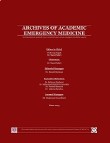Comparison of Oral Midazolam and Promethazine with Oral Midazolam alone for Sedating Children during Computed Tomography
Author(s):
Abstract:
Introduction
Both midazolam and promethazine are recommended to be used as sedatives in many studies but each have some side effects that limits their use. Combination therapy as an alternative method, may decreases these limitations. Therefore, this study aimed to compare midazolam with midazolam-promethazine regarding induction, maintenance, and recovery characteristics following pediatric procedural sedation and analgesia. Methods
Children under 7 years old who needed sedation for being CT scanned were included in this double-blind randomized clinical trial. The patients were randomly divided into 2 groups: one only received midazolam (0.5 mg/kg), while the other group received a combination of midazolam (0.5 mg/kg) and promethazine (1.25 mg/kg). University of Michigan Sedation Scale (UMSS) was used to assess sedation induction. In addition to demographic data, the child’s vital signs were evaluated before prescribing the drugs and after inducing sedation (reaching UMSS level 2). The primary outcomes in the present study were onset of action after administration and duration of the drugs’ effect. Results
107 patients were included in the study. Mean onset of action was 55.4±20.3 minutes for midazolam and 32.5±11.1 minutes for midazolam-promethazine combination (p<0.001). But duration of effect was not different between the 2 groups (p=0.36). 8 (7.5%) patients were unresponsive to the medication, all 8 of which were in the midazolam treated group (p=0.006). Also in 18 (16.8%) cases a rescue dose was prescribed, 14 (25.9%) were in the midazolam group and 4 (7.5%) were in the midazolam-promethazine group (p=0.02). Comparing systolic (p=0.20) and diastolic (p=0.34) blood pressure, heart rate (p=0.16), respiratory rate (p=0.17) and arterial oxygen saturation level (p=0.91) showed no significant difference between the 2 groups after intervention. Conclusion
Based on the findings of this study, it seems that using a combination of midazolam and promethazine not only speeds up the sedation induction, but also decreases unresponsiveness to the treatment and the need for a rescue dose.Keywords:
Language:
English
Published:
Archives of Academic Emergency Medicine, Volume:3 Issue: 3, 2015
Pages:
109 to 113
https://magiran.com/p1416452
دانلود و مطالعه متن این مقاله با یکی از روشهای زیر امکان پذیر است:
اشتراک شخصی
با عضویت و پرداخت آنلاین حق اشتراک یکساله به مبلغ 1,390,000ريال میتوانید 70 عنوان مطلب دانلود کنید!
اشتراک سازمانی
به کتابخانه دانشگاه یا محل کار خود پیشنهاد کنید تا اشتراک سازمانی این پایگاه را برای دسترسی نامحدود همه کاربران به متن مطالب تهیه نمایند!
توجه!
- حق عضویت دریافتی صرف حمایت از نشریات عضو و نگهداری، تکمیل و توسعه مگیران میشود.
- پرداخت حق اشتراک و دانلود مقالات اجازه بازنشر آن در سایر رسانههای چاپی و دیجیتال را به کاربر نمیدهد.
In order to view content subscription is required
Personal subscription
Subscribe magiran.com for 70 € euros via PayPal and download 70 articles during a year.
Organization subscription
Please contact us to subscribe your university or library for unlimited access!


